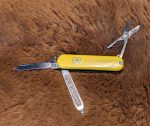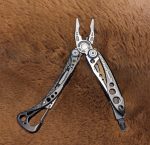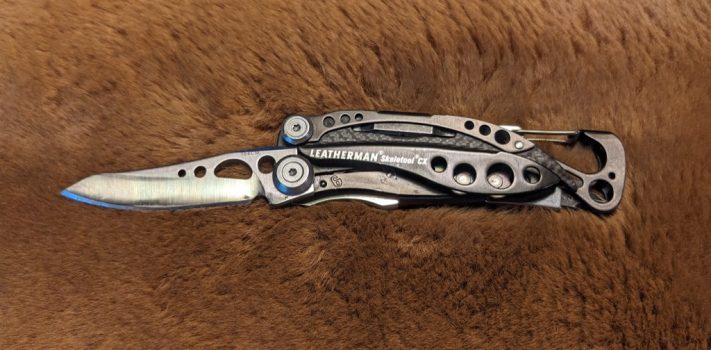With a 2.6-inch, plain-edge blade made of 154CM stainless steel, pliers, wire cutters, and a bit driver, the Leatherman Skeletool CX makes an outstanding tool for everyday carry (EDC). Priced at $89.95 at the time of this writing, it is well worth every penny. I highly recommend it.
The Backstory
I was sitting on my tackle box by a river, fishing with my grandchildren, “Cicero”, “Ernest”, and “Ginger”. We were casting a worm and bobber, and catching many small fingerlings, which we were releasing back into the river as fast as we could catch them. The grandchildren, aged 5, 3, and 2, were fully satisfied with this arrangement.
Ernest seemed to have another strike, but the line snagged on a rock as he was reeling it in. I tried to help him out, but succeeded only in breaking the line. The bobber remained anchored firmly by the snagged hook about 10 yards from shore.
The river bottom appeared firm and sloped gently from the shore. The current was not too swift. I decided to wade out and clean up our mess rather than leaving the line to potentially entangle passing wildlife.
The rescue was swiftly and easily accomplished. I was surprised to find a fingerling firmly attached to the hook as I freed the line from the rocky river bottom. I returned to shore and released the fingerling. I then cut the excess line from the sinker and hook using my original Leatherman Skeletool.
The original Skeletool was my favorite tool for EDC. I have previously reviewed it on SurvivalBlog. I liked the fact that I always had a pliers and screwdriver handy as well as a blade. After I cut the line, I returned the Skeletool to my pocket.
I wound up the excess line, and put it in my other pocket. Later that day the line proved useful as improvised thread for mending the torn canvas of a cot.
After the excess line was stowed, I reattached the hook, sinker and bobber to the end of the line on the reel, and we resumed our fishing.
A couple of hours later, after dinner, I reached into my pocket, and something did not feel quite right. The Skeletool was gone. I retraced my steps to the river bank, waded in the river, checked and rechecked my tackle box, pockets, and everywhere I had been in the last couple of hours. My efforts were in vain. The Skeletool with the name “Thomas” laser engraved on its side was lost without a trace.
I was left with a feeling of bereavement. I had lost an old friend and a daily companion. Suddenly I found myself with a host of things to cut, pinch and twist, but nothing to cut, pinch, or twist them with.
The Search
I did an internet search for a new Leatherman Skeletool, and found out that the basic Skeletool was currently running $74.95 at www.leatherman.com, while the Skeletool CX was running $89.95. I decided to see if I could find something used on eBay.
I bid on a couple of items on eBay, and finally won a nice-looking Skeletool CX for $52.15. I looked forward to the delivery of my new (to me) Skeletool with great anticipation.
The seller seemed a bit casual about getting the tool in the mail even after generating a label. I waited with growing frustration, frequently checking the tracking number. Finally, on the very last day of the projected arrival window, I found a small padded envelope in my mailbox.
First Impressions

 As I opened the padded envelope, I quickly noticed that in addition to the used Skeletool CX, the envelope contained a used yellow Victorinox Swiss Army Classic SD knife. I was surprised and pleased, and quickly forgave the seller for dawdling a bit on the shipping. The SD was in pretty good shape for a used knife, except that the main blade was bent a little, and it was not especially sharp.
As I opened the padded envelope, I quickly noticed that in addition to the used Skeletool CX, the envelope contained a used yellow Victorinox Swiss Army Classic SD knife. I was surprised and pleased, and quickly forgave the seller for dawdling a bit on the shipping. The SD was in pretty good shape for a used knife, except that the main blade was bent a little, and it was not especially sharp.
The Skeletool CX was also in relatively good shape. It showed some signs of wear from carry and use, but no signs of abuse. The blade showed some signs of inexpert sharpening, and was also not especially sharp. I fully understand this, since 154CM can be a bit challenging to rehone once it becomes dull.
The screwdriver bits showed moderate signs of wear, but were still fully useable. The pliers showed no signs of use at all.
Tuning Up the SD
I put the end of the main blade of the SD in a vise, and gently bent the blade straight again. The 1.4116 stainless steel of the SD blade was easy to sharpen with a simple AccuSharp Diamond Pro 2-Step knife sharpener. It was soon shaving sharp again.
I replaced the toothpick with a Firefly Mini ferrocerium fire starter from Tortoise Gear. I reviewed this product on SurvivalBlog back on April 4, 2021. I used a sharpening stone to polish the edge of the nail file implement to give it a more acute edge, so that I could strike sparks from the Firefly more effectively. It is handy to have a little backup fire starter in my pocket.
I then switched out the SD that I usually carry with the “new” one since it was less worn.
Tuning Up the Skeletool CX
The 154CM steel of the blade of the CX is quite a bit harder than the 1.4116 steel of the SD. As a result, it could not be quickly and easily sharpened with the AccuSharp tool.
Instead, I took the CX out to the pole barn for a session with the EdgePro Apex 4 Knife Sharpening kit that I reviewed in SurvivalBlog on May 15, 2023. One 20-minute session was sufficient to restore the blade to shaving sharpness.
Testing
I clipped the CX to my left front pocket, and began using it for EDC. The CX and the SD quickly proved themselves to be extremely useful. I used them for a host of everyday tasks during the testing period:
To remove, using the CX flat screwdriver bit, the lid from a soap dispenser that needed to be refilled.
To tighten, using the CX Phillips screwdriver bit, some screws on a set of shelves that I was moving for my wife.
To grasp, using the CX pliers, the lanyard of a chainsaw gas cap after the lanyard became detached from the cap and fell into the tank.
To cut, using the CX blade, a piece of foam to pad driver bits within a bit set case.
To slice cheese, using the CX blade, to eat with crackers and soup for supper.
To cut out, using the SD scissors, a restaurant coupon to use for ordering dinner.
To cut open, using the SD blade, a package of steak to be grilled.
To cut in half, using the CX blade, a steak to make sure that it was thoroughly grilled.
To cut packing tape, using the CX blade, so that empty boxes could be flattened.
To tighten screws, using the CX Phillips screwdriver bit, while installing a window AC unit.
To open a host of packages using the CX blade.
To install screws, using the CX Phillips screwdriver bit, into wall anchors in order to hang pictures in my newly renovated office.
To open the dog’s monthly dose of heartworm medicine using the CX blade.
To open, using the CX blade, a package of chocolate-covered almonds as a snack for our weekly small group Bible study. I cut my left index finger slightly in the process. The group commented that perhaps I should not be trusted with sharp objects.
To open, using the CX blade, the packaging for the dog’s flea and tick treatment.
To tighten, using the CX Phillips screwdriver bit, screws to hold a computer monitor to a mount.
The CX and SD performed all of these tasks with excellence.
What I appreciate most about the Skeletool is that it keeps the tools that I use most often near at hand so that I don’t have to waste a lot of time fetching them from somewhere else.
Possible Improvements
I can think of only two small improvements that could make the Skeletool, whether the original or the CX model, better.
First, if they designed the tool to take standard 1/4 inch bits rather than proprietary bits, that would significantly increase its usefulness.
 The second suggestion is a matter of personal preference with which many may disagree. I think the 420HC plain-edge blade of the Skeletool KB is significantly better than the 420HC part-plain, part-serrated blade of the original Skeletool. I also think that the Skeletool KB blade is significantly better than the 154CM plain-edge blade of the Skeletool CX. I think that the plain-edge Skeletool KB blade is better than the combo blade of the original Skeletool because I need a plain-edge blade at least 100 times for every time I need a serrated-edge blade just once. I think that 420HC Skeletool KB blade is better than the 154CM blade of the Skeletool CX because the 420HC blade is so much easier to rehone. Because of this preference, I had replaced the combo blade of my original Skeletool with the plain-edge blade of a Skeletool KB. I don’t think that I will replace the 154CM blade of the CX with a 420HC blade from a Skeletook KB because the EdgePro Apex sharpening system handles the 154CM blade so well. But if I did not have a high-end sharpening system, I would definitely make the change.
The second suggestion is a matter of personal preference with which many may disagree. I think the 420HC plain-edge blade of the Skeletool KB is significantly better than the 420HC part-plain, part-serrated blade of the original Skeletool. I also think that the Skeletool KB blade is significantly better than the 154CM plain-edge blade of the Skeletool CX. I think that the plain-edge Skeletool KB blade is better than the combo blade of the original Skeletool because I need a plain-edge blade at least 100 times for every time I need a serrated-edge blade just once. I think that 420HC Skeletool KB blade is better than the 154CM blade of the Skeletool CX because the 420HC blade is so much easier to rehone. Because of this preference, I had replaced the combo blade of my original Skeletool with the plain-edge blade of a Skeletool KB. I don’t think that I will replace the 154CM blade of the CX with a 420HC blade from a Skeletook KB because the EdgePro Apex sharpening system handles the 154CM blade so well. But if I did not have a high-end sharpening system, I would definitely make the change.
Conclusions
 In my opinion, the Leatherman Skeletool, whether the original model or the CX model, offers the best balance of portability and functionality of any EDC tool on the market today. It is said that a bird in the hand is worth two in the bush. A Skeletool in your pocket is worth a whole toolbox full of pliers, screwdrivers and knives in your trunk or on your workbench far away. I highly recommend the Skeletool, whether in its original form with a part-plain part-serrated blade made of 420HC steel, or the CX with a plain-edge blade made of 154CM.
In my opinion, the Leatherman Skeletool, whether the original model or the CX model, offers the best balance of portability and functionality of any EDC tool on the market today. It is said that a bird in the hand is worth two in the bush. A Skeletool in your pocket is worth a whole toolbox full of pliers, screwdrivers and knives in your trunk or on your workbench far away. I highly recommend the Skeletool, whether in its original form with a part-plain part-serrated blade made of 420HC steel, or the CX with a plain-edge blade made of 154CM.
Disclaimer
Tortoise Gear was kind enough to provide me with a sample of their Firefly Mini for a review that I wrote back in 2021. EdgePro was kind enough to provide me with a sample of their Apex 4 Sharpening Kit for a review that I wrote in the spring of 2023. I tried not to let their kindness interfere with my objectivity in this review or previous reviews, and believe that I have succeeded. Leatherman and Victorinox did not provide me with any financial or other inducement to mention their products in this article, nor did I receive any other financial or other inducement to mention any other vendor, product, or service in this article.










